The Triangle Motel, Raleigh, N.C.
For Flashback Friday this week we present this classic ‘photochrome’ postcard depicting the 1960s era ‘airport-modern’ Triangle Motel — and toss in a little Raleigh-Durham Airport history as an extra treat.
The Triangle Motel
Located at the Raleigh-Durham Airport in the heart of the Research Triangle Area.
Phone – Raleigh 787-8121
Durham 596-6218
Ultramodern air conditioned soundproof rooms. Remote control TVs. Direct dial telephones. Conference room. Large pool. Near excellent restaurants. 100 yds. to airport terminal. Adjacent to transient aircraft ramp.
Perhaps it was a traveling boyfriend awaiting a connecting flight at RDU in 1968 who dashed off this quick note to his girl back home in Pennsylvania.
Stopped off here for the night – on to Knoxville tomorrow. [signature illegible]
The Triangle Motel was probably built in the mid-1960s. This was an era of increased popularity and ease of air travel, and on-site accommodations were considered a convenience to the traveling public.
During the ensuing decades, Raleigh-Durham Airport, the Gateway to the Triangle, greatly expanded its physical facilities as it experienced tremendous growth in the number of airlines and passengers it serviced. And yet, with all that growth surrounding it, the ‘ultramodern’ motel with its ‘air conditioned sound proof rooms’ stayed put.
The chrome postcard below shows the Triangle Motel site in context with the RDU terminal in 1972.
Ultimately, the 21st century caught up with the the Triangle Motel when the RDU Airport Authority demolished the aging mid-60s hostelry for an expanded parking lot and massive multi-deck parking garage in 2000.
From Regional Airfield to International Hub: The Metamorphosis of Raleigh-Durham Airport
Raleigh’s Municipal Airport, the first regional airfield in the central Piedmont, opened three miles south of the city in 1929. A decade later the small facility could no longer accommodate commercial air traffic, so the state legislature established the Raleigh-Durham Aeronautical Authority to oversee construction and management of a modern airport. In 1940 a site was chosen midway between Raleigh and Durham, and thus the Raleigh-Durham Airport was born.
World War II intervened during construction and, in 1942, the federal government took over the unfinished facility, designating it the Raleigh-Durham Army Air Field in January 1943. Although limited passenger service continued during the war years, the airfield served as a training facility for the Army Air Corps until January 1948. RDU airport itself was returned to full civilian control in 1946 and its first permanent terminal was built.
The brand new RDU terminal as it appeared in 1946.
Eastern Airlines had been the lone passenger carrier at RDU since 1943. Capital Airlines, began service at RDU in 1947, followed by Piedmont Airlines in 1948, bringing the total daily flights to 22. As air service continued to increase, the airport authority erected a commodious, modern brick terminal in 1955. Even with later additions and improvements, this structure remained essentially as it was built for the next 27 years.
These photos show the RDU terminal as it appeared about 1957.
RDU saw a significant expansion with the erection of ‘Terminal A’ in 1982 adjacent to the 1955 facility, which was then designated ‘Terminal B’. In the three decades since then RDU has grown tremendously, beginning with the addition ‘Terminal C’ in 1987. A 12-story FAA Air Traffic Control Tower opened in May 1987. And RDU went ‘international’ in 1996 when Air Canada introduced service to Toronto. The RDU Aiport Authority built a $40 million terminal area parking garage in 2000, which added a total of 2,700 new parking spaces between Terminals A and C.
In 2006 Terminal C was demolished and replaced by Terminal 2, a 550,000 square foot facility, which opened for service in 2008. In July 2012, a major reconstruction began on Terminal A, which was renamed Terminal 1. Sadly, when the project is complete, the older Terminal B, which had served as the Gateway to the Triangle since 1955, and has witnessed phenomenal change at the airport for nearly 6o years, will probably be razed.
Terminal 2 at night — Raleigh-Durham International Airport meets the 21st century.
This week’s ‘photochrome’ postcard was published by Raleigh’s long-time, and revered studio photograper, Burnie Batchelor. It was produced by the postcard company Thomas Dexter Press of West Nyack, NY.
Thomas Dexter Press  1934-1980
West Nyack, NYPrinter of a wide variety of postcards subjects as linens and photochromes. Thomas A. Dexter was the inventor of gang printing. The Company merged with MWM Color Press in 1980 to become MWM Dexter, and they moved to Aurora, MO.
While all the photochromes printed by Dexter bore the words Genuine Natural Color they went through a variety of phases. Their early photochromes went under the name Dextone and tended to be flat and somewhat dull in appearance. As years went by their optical blending techniques improved producing richer and more varied colors.
“Flashback Friday†is a weekly feature of Goodnight, Raleigh! in which we showcase vintage postcards depicting our historic capital city. We hope you enjoy this week end treat!

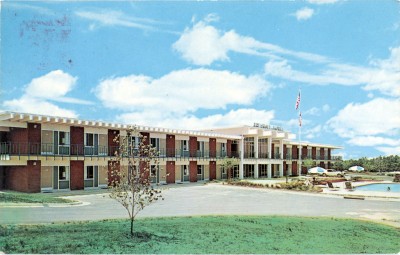


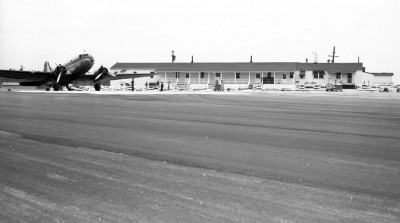
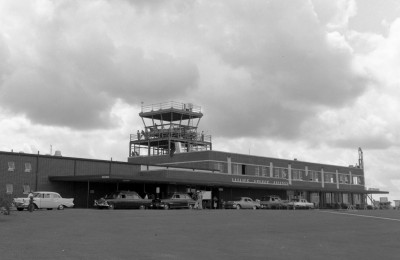
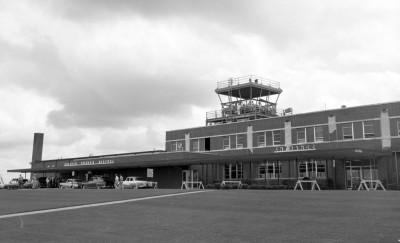
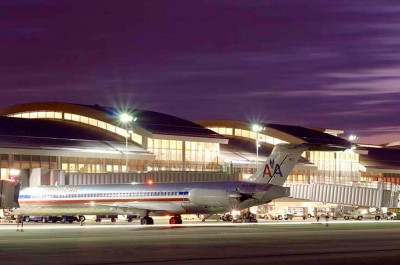

 Sign up for the Newsletter
Sign up for the Newsletter
02/22/2013
I remember running right out on the tarmac to greet folks back when I was a kid. Wow – I’m old.
02/22/2013
Thanks as always. I love flashback Friday!
02/22/2013
There is another Burnie Batchelor photo of the motel in UNC’s Durwood Barbour postcard collection. It may have been taken later, after the motel was expanded:
http://dc.lib.unc.edu/cdm/singleitem/collection/nc_post/id/8349
02/23/2013
yeah NCSU, I too remember standing out on that tarmac to see people off on a journey/welcome them back home. I always got a rush (almost literally) when the propellers started up. I also remember when going out to the airport was pretty much an out-of-town trip in itself. Guess that really makes me old.
02/23/2013
During the 9th grade our science teacher, Mr Rudder, took our class on a field trip to RDU. The highlight of the trip was when we were allowed to walk through an airplane. I don’t remember the airline, but it was a two engine, prop plane. That was really cool.
Later, other “trips” were taken late at night lying on the concrete at the end of the runway watching airplanes arrive and depart. That was really cool.
02/23/2013
I remember staying overnight at the Triangle Motel in the early 60’s; the family had gone out to the ends of the earth to pick up somebody, don’t remember who, at night. Wasn’t real late, but I remember the flight was the last of the day, maybe 9 p.m. The flight was delayed because of weather, we found out after we had trekked out there, and our traveller would be coming in on a morning flight. My father bought insurance out of a machine on whoever was coming in, just in case the plane went down, he would at least make a few bucks.
My parents decided, rather than long-distance-hauling our tired bodies home and back again, we’d stay at the motel overnight. What a treat, eating at the airport cafe, getting up before dawn to watch the planes go out. The motel was nice, new, not the usual WWII-era rat’s nests my, uh, thrifty parents usually chose. I remember my father arranged for us to tour one of the plane’s interiors, and the pilot gave us little wing pins.
Not a bomb-sniffing dog or underwear-bomber in sight, or thought.
02/23/2013
Triangle Motel became a Best Western in the late eighties (or early nineties):
http://www.harrellsign.com/random_pictures/Best-Western-Triangle-Inn.jpeg
02/25/2013
I never stayed there, but in the mid-1980s the motel’s front desk was a dropoff point for paper airline tickets from several corporate travel agencies in the Triangle… so I dropped in on occasion to pick up a ticket. Like walking into a time machine… I don’t believe a dime had been spent on the motel since it opened.
At that time the rental car company lots were still in front of Terminals A and B. When American opened Terminal C and its parking garage, things began to change rapidly… within a few years the motel was gone, taxis no longer queued at Terminal A, rental cars were moved to their current location (soon to move again), and later the big parking deck was built.
03/01/2013
NCSU and RG: I also have fond memories of old RDU — the outdoor gates, the shoe-polishing stand in the lobby, and especially the large image of the Wright Bros 1st flight embedded in the terrazzo floor. Sadly, I doubt this will be preserved when the old terminal is demolished.
HG, RN51 and CT: Thanks for sharing your memories of the Triangle Motel — those sure were the days! btw– I remember Mr Rudder, too!
Curt and Jim: Thanks for linking the pics of the triangle Motel depicting its transition over the decades.
Tania: I’m glad you enjoy our FF posts! We are taking a brief hiatus this week, but will return next Friday, same Bat-Time, same Bat-Channel. ;)
04/20/2017
Hey guys
I am so dying to hear more! I am writing a book about RDU and want to make the book as personal and have as many first hand accounts as possible . Any one interested ? I hope maybe I could interview or possibly hear more on here since I don’t know the privacy protection but I really would like to hear more any memories help me !
05/05/2021
My mother, who is 90, remembers the first wooden building and her father’s first business flight to New York in the 1940’s. Inside the terminal, where he purchased his ticket the day of travel, a pot belly stove kept passengers warm as they waited. Her family was allowed to board the Eastern Airlines plane with him to say goodbye.